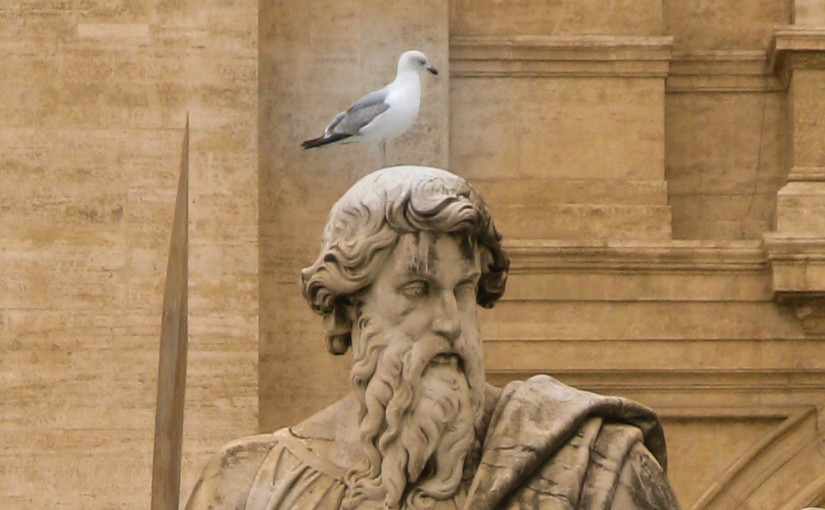Wandering among the ancient ruins in Roman Forum and Palatino, gazing at the marvelous ceiling of the Sistine Chapel, and transfixed by the monumental Colosseum, I felt connected with Rome’s rich and glamorous past. With the help of some self-indulgent imagination, I can easily picture myself walking with senators of the Roman Republic along Via Sacra, or watching Michelangelo painting his masterpiece, or hearing ten thousand people cheering at gladiators slaying beasts. These illusions of grandeur easily swelled me with a sense of self-importance; it is dangerous, for mental health, among many other things. A quick read of Roman history (and the history of Italy) made me realize the disproportionately large number of Roman emperors who became insane or mad (literally, not figuratively) and how those who tried to emulate their glory often ended up on the wrong side of history. Mortal danger indeed.
So, to keep those grandiose thoughts in check, I will first write about the trivialities of my trip in Rome.
Toilets are hard to find in Rome. It is a real challenge. Public toilets are often located near main tourist attractions. The entrance fee is anywhere from fifty cents to one euro. Toilets inside museums are free. But sometimes, the queues are long, and it is not uncommon for the gents’ and ladies’ toilets to be in one room. The labels of the public toilets around St. Peter’s Basilica and St. Angelo’s Castle are not easily seen. You may have to ask the police or local workers where the toilets are. Restaurants’ toilets are only for customers, and the cleanness of the toilets is positively correlated with the price of the restaurants. Bars that sell sandwiches and pizza usually don’t have toilets. However, I once wandered into the pedestrian shopping districts near Pantheon and found a pay toilet inside an ice cream and cookie shop. All in all, the touristy places in Rome are small enough to walk but large enough for the unprepared to test the elasticity of his/her bladder. I wish google map has labels for public toilets.
Food can be expensive. It should go without saying that one should only buy things after looking at their price. But following common sense hasn’t been my strong suite. The first morning in Rome, I had a 21-euro breakfast; the food was excellent, but it was definitely overpriced. I wouldn’t have had the meal there if I had seen the menu with price before ordering. The cheapest way to eat, according to Lonely Planet, is to buy sandwiches or pizzas at bars and eat on the go. One sandwich or one slide of pizza is around 2 to 4 euros. I did just that when wandering aimlessly in the city and when I visit the Roman Forum, the Palatino, and the Colosseum.
Navigation is a piece of cake with google map at hand. Paper maps are good to have too, especially when the smartphone battery is running low.
Trains in Italy are usually crowded, often run late, and always need reservations. On my way to Milan, the train was late for 30 mins, I almost missed the connecting train to Rome. And the train to Rome was late for half an hour as well. I met a couple from Alberta on the train to Milan, and they told me that trains in Italy are usually delayed. One also has to look for the platform number inside the train station. Reservation has to be made in advance, even with train passes like Eurorail pass. It took ten euro for my trains within Italy and eleven euro for my international trains into and out of Italy. The reservation can be done either on the web or at the self service machines in train stations (in theory). I didn’t make the reservation for trains back to Stuttgart. I regretted the decision after seeing the long long queue in front of the ticket office in Rome train station (and in Florence too). My reservation from Milan to Basel somehow cannot be printed out at the self-service machine, so I had to join the queue.
Electric adapter. Unique Italian. German adapter won’t work.
Queues for Vatican Museum and St Peter’s Basilica are long. I booked tickets for the museum online beforehand, and on my first day of the museum visit when I saw the queue, I felt that was the smartest decision I have made for a long time. St. Peter ‘s Basilica, however, has no online booking system. The entrance is free. But one day in the early morning around nine o’clock, I got in without queuing.
Lastly, freshly squeezed orange juice is a must. Almost every bar has a machine for it. I saw the bar attendants squeezing the juice with the machine several times; it takes about four to five oranges to make one glass of juice. The taste of freshness is addictive.
